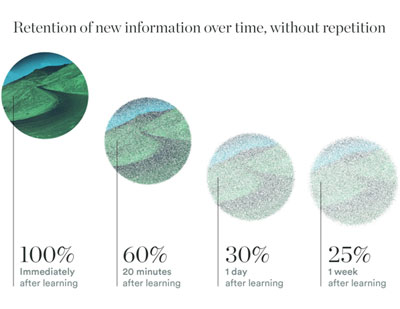What Is the Learning Curve and How Does It Work for Effective Sales Training?
 |
|
by Dimuthu Calyaneratne |
We’ve all heard the phrase “practice makes perfect”, but where does it come from? In corporate learning environments, we often speak of the learning curve; but what does the learning curve mean, and how can companies maximize its impact in the context of corporate training?
The history of the learning curve
In 1885, Hermann Ebbinghaus coined the term we now know as the learning curve. What is it? Well, put simply, it’s the idea that practice makes perfect.
Ebbinghaus tested the theory himself by memorizing a series of nonsense syllables and documenting his success at reciting them back. The result? When he repeated the same task over and over again, he was not only more likely to remember, but also less likely to forget. He initially referred to this as the Forgetting Curve—realizing that if learning is rehearsed and repeated over a period of time, we forget less and remember more.
Now, reading this today, it sure sounds like a common sense principle. We all understand that the more we do something, the better we’ll get. But up until Ebbinghaus’s experiment, no one had taken the time to study human memory.
The famous graph
The learning curve is often seen as a graphical representation where experience (time, trials, etc.) is on the x-axis and learning (performance, knowledge, etc.) is on the y-axis, emphasizing the idea that learning improves with experience.
Why the learning curve is key to great training
Why should we care? As a society, we spend a lot of time identifying the different ways people learn. We understand that some people are visual learners, others are auditory, and we recognize that no learner is the same in regards to how long it takes them to grasp a subject.

FREE DOWNLOAD FOR EFFECTIVE SALES TRAINING - https://forms.gle/f7cjei3gQHoVvBKb9

Because of this, we’ve seen a rise in a more hands-on and technology-focused approach to teaching in school—which is excellent! This same principle should be applied in business, too.
If we know that an employee performs better with continued experience and training, why do we throw them into the line of fire with minimal resources? Or, a better question might be, why do we continue to spend time and money on the same training that hasn’t proven to be useful in the past?
Two tips for implementing the learning curve
1. Use interactions to boost learner retention
Interactions are opportunities in training for learners to apply what they’ve learned in practice. This is super important for adult learners, who often absorb information more readily when there is reality-based application. We learn best by doing, just as Ebbinghaus discovered.
With eLearning, interactions could include flashcards, quizzes, accordions, or tabs. For an even stronger impact, opt for scenario-based learning to mimic the real world—giving learners an opportunity to get up close and personal with the skills they’re learning. If you’re in a traditional training setting, roleplay exercises make for powerful interactions (coupled with a debrief) to boost retention.
In a utopian fantasy world built on efficiency and productivity, one-off training for employees would cover a company’s entire learning needs. That’s exactly what it is though, a fantasy. And the learning curve tells us that the more times learners practice and repeat what they learn, the more they’ll retain the education.
Enter blended learning: instructor-led training that is enhanced through post-session eLearning such as online practice questions, scenario learning, or video roleplay assignments. The best part? This kind of training maximizes the effectiveness of in-person learning and eLearning keeping your team on the learning curve.
Invest in effective training to maximize the learning curve
When it comes to training, research shows that within an hour, people will have forgotten an average of 50% of the information they just learned. Within 24 hours, they have forgotten an average of 70% of new information, and within a week, forgetting claims an average of 90%.
To improve productivity and efficiency in the now, we should start cutting costs on training that isn’t working and start investing in smarter options. Let’s take Ebbinghaus’s discovery that people learn more and forget less when they are given the information in small, bite-sized pieces over time.
You can do this by providing them with comprehensive apps and eLearning that allows the employee access to the quality resources they need when they need it. Not only that, but it fosters an environment that continues to challenge their learning even after their formal training has been completed—using customized methods that have been proven to deliver positive results.
Principles that Differentiate Adult Learners
1. Adults need to understand the “why” behind learning
If you approach adult learners having already defined why your subject matter is valuable for them, you’ve already crossed a major hurdle. Start here and branch out from this value.
Unlike children who are placed in learning environments by their caregivers, adults are generally motivated to learn by internal forces like bettering their salary or improving their skills for a future aspiration. Companies with successful adult learning know this, and because they take the time to provide learning that is valuable to their employees, they also see positive results in their workplaces.
Ultimately, when your content has a higher perceived value, it will generate more interest and overall commitment to the learning process. What was once a lackluster job training has the potential to become an engaging experience, leading to higher employee performance and job retention.
2. Adult learners draw from lived experience
Children are often approached with a curriculum as if their brains are completely empty, waiting to be filled with information.
This may work to teach a child their ABC’s, but adults are not like children. Adult minds are already full of preconceived ideas, personal values, and years of lived experience. From a brain science perspective, your adult learning should be tasked with connecting your curriculum with the ideas and knowledge they already have.
When adults are provided with content that connects directly to their lives, you will see learning move from being a transfer of knowledge to a conversation between teachers and students. This way of learning is more dynamic and produces better long-term results.
3. Adults use learning as a form of problem-solving
Similar to the second assumption, adults generally do not like learning for learning’s sake. However, if you can root learning content in real problems and circumstances your students encounter, their response will be to care more.
As a rule, adults don’t want to spend copious amounts of time learning a new idea if it doesn’t immediately provide value in their lives or career.
Find ways to demonstrate the return on investment to your adult learners for their time and attention, and you’ll have adults that care more and perform better as a result.
4. Adults move towards self-directedness as they learn and grow
As if adults couldn’t get any more complicated—they suddenly do. As they learn, they move from dependence towards self-directedness. Essentially, adults have a need for ownership in the learning process, and it’s important to provide opportunities for ownership throughout your curriculums.
Similarly to the “teach a man to fish” Chinese proverb, an adult’s interest in a subject is usually congruent to the amount of responsibility they have over it.
Tips for successful adult learning
Understanding what makes adult learners unique is one thing, but learning how to convert our understanding into practice is what matters most. Here are 5 tips you can apply today to see better results with your employees and learners.
1. Break content down into small steps or microlearning
Adults aren’t going to be happy if you waste their time. They want to know that the time they spend learning is going to provide value and give them ample time to apply what they’ve learned.
By taking large concepts and breaking it into 10-minute learning moments or microlearning, it’s more likely to be remembered by your students and will result in better performance outcomes.
2. Use traditional elements of gameplay to create interesting and action-driven curriculums for adult learners
Who doesn’t love a good game night? While the idea of gamification may seem like a less serious version of learning, it has been proven to increase learning effectiveness in adults.
Try incorporating things like characters, rules, interactivity, and scoring into your curriculum to engage the competitive side of your learners and motivate progress.
3. Ground your learning content in real-world examples
There is a time and a place for theoretical learning, but when it comes to adult learning, find as many opportunities as possible to ground content in real-life scenarios.
Curricula that take the time to provide everyday examples of concepts provide a reminder of value to adult learners. This will help keep motivation and interest high throughout the learning process while also providing plenty of opportunity for practice and application.
4. Create a safe environment for failure
Before a soldier’s boots hit the combat field, they go through intense simulations with their comrades where they must navigate their way through failures in order to learn from their mistakes and plan future success. As it turns out, failure is a crucial part of the learning process and one that we should apply to every adult learning environment.
And in reality, there’s no better place for your employees to fail than within a training curriculum. By providing simulations or moments of interactivity in training, you not only give adult learners the opportunity to fail, but also to learn from their failures for the better.
-
Still No Comments Posted.


















Leave Comments